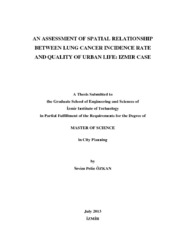Please use this identifier to cite or link to this item:
https://hdl.handle.net/11147/3578Full metadata record
| DC Field | Value | Language |
|---|---|---|
| dc.contributor.advisor | Saygın, Mustafa Ömür | - |
| dc.contributor.author | Özkan, Sevim Pelin | - |
| dc.date.accessioned | 2014-07-22T13:51:51Z | - |
| dc.date.available | 2014-07-22T13:51:51Z | - |
| dc.date.issued | 2013 | - |
| dc.identifier.uri | http://hdl.handle.net/11147/3578 | - |
| dc.description | Thesis (Master)--Izmir Institute of Technology, City and Regional Planning, Izmir, 2013 | en_US |
| dc.description | Includes bibliographical references (leaves: 130-138) | en_US |
| dc.description | Text in English; Abstract: Turkish and English | en_US |
| dc.description | xvi, 152 leaves | en_US |
| dc.description.abstract | The study assesses spatial clusters of lung cancer incidences within Izmir province on the basis of districts and also neighborhood using an objective sets of quality of life indicators. Lung cancer data, approximately 18.000 cases, were acquired from the Izmir Cancer Registry Center (ICRC) between the years of 1992-2007. Cases have been confirmed in terms of accuracy by World Health Organization (WHO). As objective indicator data, point source air pollution data acquired from the Izmir Metropolitan Municipality database between the years of 1993-2007. Besides, socio-economic statistics data were obtained from Turkish Statistical Institute (TSI) regional indicators (2000,2007) and Izmir Metropolitan Municipality city health profile (2007). The datasets were used to determine whether there is a significant spatial relationship between cancer case density and environmental contamination. This thesis uses spatial statistical models and Geographical Information System (GIS) techniques to analyze population-based cancer incidence rate. Additionally, Age Standardized Incidence (ASR) of the lung cancer was calculated. Spatial autocorrelation technique was performed to investigate local distribution of lung cancer. Results of the study suggest that spatial clusters of lung cancer were detected in geographic locations with low level environmental quality and high level socio-economic profile. Then, the results are discussed in terms of life quality and environmental quality of Izmir. The results of this study are useful for interdisciplinary researchers, epidemiological studies, policymakers and governmental agencies in terms of health and environmental assessment, regulation and control of spatial strategies. | en_US |
| dc.language.iso | en | en_US |
| dc.publisher | Izmir Institute of Technology | en_US |
| dc.rights | info:eu-repo/semantics/openAccess | en_US |
| dc.subject.lcsh | Cancer--Environmental aspects | en |
| dc.subject.lcsh | Health status indicators--Turkey | en |
| dc.subject.lcsh | Spatial analysis (Statistics) | en |
| dc.subject.lcsh | Geographic information systems | en |
| dc.subject.lcsh | City and town life--Turkey | en |
| dc.title | An Assessment of Spatial Relationship Between Lung Cancer Incidence Rate and Quality of Urban Life: Izmir Case | en_US |
| dc.type | Master Thesis | en_US |
| dc.institutionauthor | Özkan, Sevim Pelin | - |
| dc.department | Thesis (Master)--İzmir Institute of Technology, City and Regional Planning | en_US |
| dc.relation.publicationcategory | Tez | en_US |
| dc.identifier.wosquality | N/A | - |
| dc.identifier.scopusquality | N/A | - |
| item.openairecristype | http://purl.org/coar/resource_type/c_18cf | - |
| item.languageiso639-1 | en | - |
| item.openairetype | Master Thesis | - |
| item.grantfulltext | open | - |
| item.fulltext | With Fulltext | - |
| item.cerifentitytype | Publications | - |
| Appears in Collections: | Master Degree / Yüksek Lisans Tezleri Sürdürülebilir Yeşil Kampüs Koleksiyonu / Sustainable Green Campus Collection | |
Files in This Item:
| File | Description | Size | Format | |
|---|---|---|---|---|
| T001112.pdf | MasterThesis | 13.4 MB | Adobe PDF |  View/Open |
CORE Recommender
Page view(s)
314
checked on Mar 31, 2025
Download(s)
128
checked on Mar 31, 2025
Google ScholarTM
Check
Items in GCRIS Repository are protected by copyright, with all rights reserved, unless otherwise indicated.